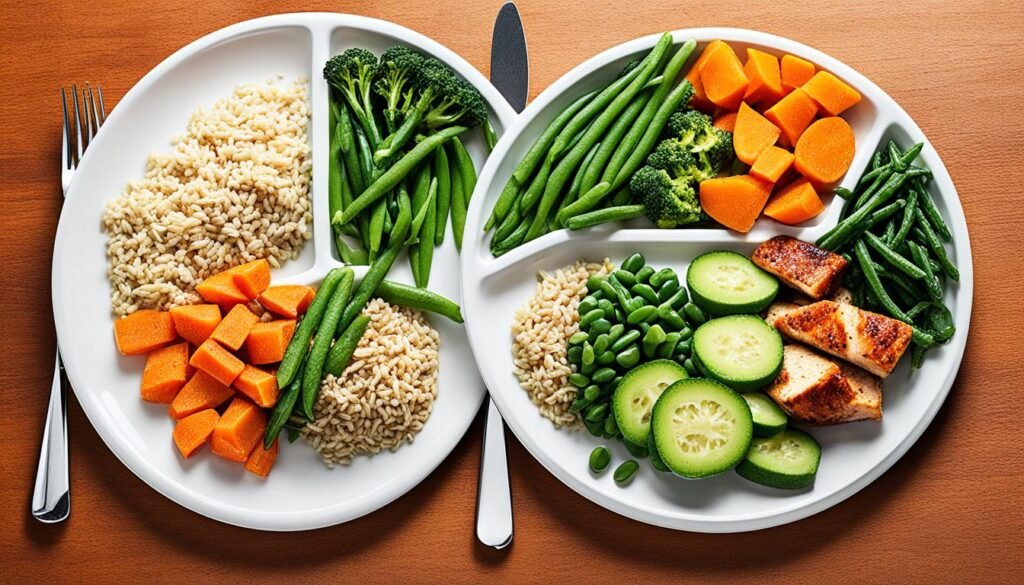Discover the Best Diabetes Diet Plan for Better Health
Navigating the world of diabetes management can be a daunting task, but fear not – the key to better health lies in embracing the right diabetes diet plan. This eating strategy is designed to help individuals with diabetes or prediabetes control their blood sugar levels, manage their weight, and prevent the onset of serious complications. By adopting a diabetes-friendly diet, you’ll embark on a journey towards optimal wellness, empowered with the knowledge to make informed choices and take charge of your health.
Key Takeaways
- A diabetes diet emphasizes healthy, whole-food choices to manage blood sugar levels and prevent complications.
- Incorporating heart-healthy fats, and fiber-rich foods, and limiting saturated fats and sodium can improve overall health.
- Regular, balanced meals and portion control are crucial for maintaining steady blood sugar levels.
- Collaborating with healthcare providers and registered dietitians can help create a personalized, effective eating plan.
- Adopting a diabetes-friendly diet can reduce the risk of cardiovascular disease and certain types of cancer.
Understanding the Importance of a Diabetes Diet
If you have diabetes or prediabetes, a healthy eating plan is crucial for controlling your blood sugar levels and managing the condition. Uncontrolled blood sugar can lead to serious problems, such as nerve, kidney, and heart damage. A diabetes diet helps you keep your blood sugar in a safe range by making healthy food choices and tracking your eating habits. Additionally, weight loss through a healthy diet can make it easier to control blood sugar for those with type 2 diabetes.
Following a diabetes diet offers other benefits, such as lowering the risk of cardiovascular diseases and certain types of cancer. Let’s delve deeper into the importance of a diabetes-friendly eating plan.
Why a Diabetes Diet is Crucial for Blood Sugar Control
Type 1 diabetes is characterized by the lack of insulin production in the body, while type 2 diabetes involves ineffective insulin production or usage by the body. Prediabetes indicates higher blood glucose levels than normal but not meeting the criteria for diabetes diagnosis. Having prediabetes increases the risk of developing type 2 diabetes.
Monitoring and controlling blood glucose levels through diet reduces the risk of diabetes-related health issues like vision loss and heart problems. There is no one-size-fits-all diet plan for diabetes; individualized plans consider factors like medication, weight, health conditions, lifestyle, and goals.
The Role of a Healthy Diet in Diabetes Management
Healthy diabetes diets emphasize a variety of foods from all food groups: fruits, vegetables, whole grains, proteins, and nonfat or low-fat dairy. To manage blood glucose levels, individuals with diabetes should limit high-carb foods like sugary items, drinks with added sugars, white rice, starchy vegetables, fried foods, and high-sodium foods.
Proper portion control and timing of meals is crucial for managing blood glucose levels. Learning to count carbs and sticking to a balanced eating plan at home and when dining out is essential for diabetic individuals. Following a healthy diet to control blood glucose levels requires effort but offers the chance to live a healthier life with diabetes.
Principles of a Diabetes-Friendly Eating Plan
When it comes to managing diabetes, the principles of a healthy, diabetes-friendly eating plan are crucial. At the heart of this approach lies a focus on healthy carbohydrates and fiber-rich foods. By making strategic choices, individuals with diabetes can better control their blood sugar levels and support their overall well-being.
Choosing Healthy Carbohydrates
Not all carbohydrates are created equal. The glycemic index, a measure of how quickly a food raises blood sugar levels, is an important consideration. Complex carbohydrates, such as fruits, vegetables, whole grains, and legumes, are the preferred sources as they break down more slowly, resulting in a more gradual rise in blood sugar. In contrast, simple carbohydrates, found in added sugars, refined grains, and processed foods, can cause rapid spikes in blood sugar levels and should be limited.
Incorporating Fiber-Rich Foods
Dietary fiber is a vital component of a diabetes-friendly eating plan. Fiber-rich foods, including vegetables, fruits, nuts, and whole grains, not only help moderate the digestion of carbohydrates but also promote better blood sugar management. Incorporating these nutrient-dense options into meals and snacks can have a meaningful impact on an individual’s ability to manage their condition effectively.
| Healthy Carbohydrate Sources | Fiber-Rich Foods |
|---|---|
|
|
By focusing on healthy carbohydrates and fiber-rich foods, individuals with diabetes can better manage their blood sugar levels and overall health. This balanced approach helps to regulate the digestion of carbohydrates, reducing spikes and supporting long-term blood sugar management.
“Incorporating fiber-rich foods into your diabetes diet can have a significant impact on blood sugar control and overall health.”
Essential Components of a Diabetes Diet
A diabetes-friendly diet goes beyond just managing carbohydrates. To achieve optimal health, individuals with diabetes should also prioritize heart-healthy fish and “good” fats as essential components of their dietary approach.
Heart-Healthy Fish for Diabetes
Incorporating heart-healthy fish like salmon, mackerel, tuna, and sardines into a diabetes diet is crucial. These fish are rich in omega-3 fatty acids, which have been shown to help prevent heart disease – a common complication of diabetes. Omega-3s can also support overall cardiovascular health and cholesterol management, further reducing the risk of heart-related issues.
Experts recommend consuming fatty fish at least twice a week to reap the full benefits of these omega-3 fatty acids. By making fish a regular part of the diabetes diet, individuals can enjoy the dual advantages of improved blood sugar control and enhanced heart health.
Incorporating “Good” Fats
In addition to heart-healthy fish, a diabetes diet should also include monounsaturated and polyunsaturated fats. These “good” fats can be found in avocados, nuts, seeds, and plant-based oils, such as olive, canola, and peanut oil. Incorporating these healthy fats into meals and snacks can help lower cholesterol levels and support overall cardiovascular health.
By prioritizing heart-healthy fish and good fats, individuals with diabetes can create a balanced, nutrient-rich diet that not only helps manage blood sugar levels but also reduces the risk of other diabetes-related complications.
“Eating a diet rich in heart-healthy fish and good fats is an essential part of managing diabetes and reducing the risk of cardiovascular disease.”
Foods to Avoid on a Diabetes Diet
When managing diabetes, it’s crucial to steer clear of foods high in saturated fats, trans fats, cholesterol, and sodium. These unhealthy components can contribute to diabetes complications, such as cardiovascular disease. By limiting the intake of these problematic ingredients, individuals with diabetes can better control their blood sugar levels and promote overall health.
One of the primary culprits to avoid are high-fat dairy products, which are often loaded with saturated fats. Similarly, animal proteins like butter, beef, hot dogs, and bacon should be consumed in moderation, as they can also be high in saturated fats. Processed snacks and baked goods containing trans fats should also be off-limits, as these artificial fats have been linked to insulin resistance and an increased risk of diabetes complications.
Sodium is another nutrient that requires careful monitoring for those with diabetes. Canned, packaged, and processed foods tend to be high in sodium, which can lead to high blood pressure and other cardiovascular disease risks. It’s important to read nutrition labels and choose low-sodium options whenever possible.
Healthier Alternatives
- Opt for low-fat or non-fat dairy products, such as Greek yogurt and cottage cheese.
- Choose lean protein sources like grilled chicken, fish, and legumes.
- Enjoy healthy fats from avocados, nuts, seeds, and plant-based oils.
- Incorporate fiber-rich whole grains, fruits, and vegetables into your meals.
By making these simple swaps, individuals with diabetes can create a balanced, diabetes-friendly diet that helps manage blood sugar levels and reduce the risk of diabetes complications.
“Eating the right foods can make a significant difference in managing diabetes and improving overall health.” – Registered Dietitian, Jane Doe
| Food Group | Recommended Choices | Foods to Avoid |
|---|---|---|
| Dairy |
|
|
| Protein |
|
|
| Fats |
|
|
| Carbohydrates |
|
|
| Sodium |
|
|
By making informed choices and focusing on nutrient-dense, diabetes-friendly foods, individuals with diabetes can enjoy a balanced, satisfying diet that helps them manage their condition and reduce the risk of cardiovascular disease and other diabetes complications.
diabetes diet
Navigating the world of diabetes can be a daunting task, but the key to managing this condition lies in adopting a diabetes-friendly diet. The diabetes diet, also known as a healthy eating plan for diabetes, is designed to help individuals with diabetes control their blood sugar levels and maintain overall well-being. This approach emphasizes the consumption of nutrient-dense, low-glycemic foods, such as fruits, vegetables, whole grains, and lean proteins, while limiting foods high in added sugars, unhealthy fats, and sodium.
By following a diabetes diet, individuals can better regulate their blood sugar, maintain a healthy weight, and reduce the risk of diabetes-related complications. This dietary plan is a crucial component of healthy eating and meal planning for those living with diabetes.
One of the primary goals of a diabetes diet is to control blood sugar levels by choosing the right carbohydrates. These include high-fiber, nutrient-rich options like whole grains, legumes, and certain fruits and vegetables. By incorporating these healthy carbohydrates, individuals can help stabilize their blood sugar, reducing the risk of spikes and crashes.
Fiber-rich foods are also an essential part of a diabetes-friendly eating plan. Foods high in fiber, such as vegetables, fruits, and whole grains, can help slow the absorption of carbohydrates, leading to more gradual increases in blood sugar levels. This can be particularly beneficial for individuals with diabetes, as it helps manage their condition more effectively.
In addition to focusing on healthy carbohydrates and fiber-rich foods, a diabetes diet also emphasizes the importance of incorporating heart-healthy fats and lean proteins. These nutrient-dense components can help control blood sugar, support overall health, and reduce the risk of diabetes-related complications, such as cardiovascular disease.
By embracing the principles of a diabetes diet, individuals can take a proactive approach to managing their condition and improving their quality of life. With the guidance of healthcare professionals, such as registered dietitians, individuals can create personalized meal plans that cater to their unique needs and preferences, ensuring a sustainable and effective path to better blood sugar control and overall wellness.
Meal Planning Strategies for Diabetes
Effective meal planning is a crucial aspect of managing diabetes. Two key strategies that can help individuals with diabetes maintain healthy blood sugar levels are the Diabetes Plate Method and carbohydrate counting with portion control.
The Plate Method for Balanced Meals
The Diabetes Plate Method is a simple and visually engaging approach to creating balanced meals. This method suggests dividing your plate into three distinct sections:
- Half of the plate should be filled with non-starchy vegetables, such as leafy greens, broccoli, or cauliflower.
- One quarter of the plate should be dedicated to a lean protein source, like grilled chicken, baked fish, or tofu.
- The remaining quarter should be reserved for a healthy carbohydrate, such as whole grains, brown rice, or a small portion of a starchy vegetable.
By following the Plate Method, you can ensure that your meals are balanced, providing the right mix of nutrients to help manage your diabetes and maintain healthy blood sugar levels.
Carbohydrate Counting and Portion Control
In addition to the Plate Method, carbohydrate counting and portion control are essential strategies for diabetes meal planning. Carbohydrates have the most significant impact on blood sugar levels, so it’s important to monitor your intake and adjust your insulin accordingly.
Portion control is also crucial for maintaining healthy blood sugar levels. Using a 9-inch plate can help you visually gauge the appropriate serving sizes for your meals. Additionally, being mindful of your food portions and making healthy substitutions, such as swapping processed snacks for fresh fruits and vegetables, can further support your diabetes management efforts.

By incorporating these meal planning strategies into your daily routine, you can take control of your diabetes and enjoy balanced, nutritious meals that support your overall health and well-being.
Snacking Tips for Blood Sugar Management
Navigating the world of snacking can be tricky when you have diabetes, but with the right approach, healthy and delicious options can be part of your balanced eating plan. The key is to choose diabetes-friendly snacks that combine protein, fiber, and healthy fats to help stabilize your blood sugar levels between meals.
One of the best snack ideas is to pair fresh fruit with a serving of nuts or nut butter. For example, enjoy an apple or banana with a tablespoon of peanut or almond butter. This combination provides a satisfying blend of nutrients that can curb hunger and prevent blood sugar spikes.
- Other diabetes-friendly snacks include:
- Sliced vegetables (like carrots, bell peppers, or cucumber) with hummus or guacamole
- Greek yogurt topped with berries and a sprinkle of cinnamon
- Hard-boiled eggs with a sprinkle of salt and pepper
- Roasted chickpeas or edamame
- Cottage cheese with fresh fruit
When it comes to blood sugar management, portion control is also key. Aim for snacks that contain around 15-30 grams of carbohydrates, which can help prevent blood sugar spikes. And remember, the healthiest snacks are often those that are minimally processed and rich in protein, fiber, and healthy fats.
“Snacking can be an important part of a diabetes meal plan, but it’s crucial to choose the right foods to keep blood sugar levels stable.”
By incorporating these diabetes-friendly snack tips into your routine, you can enjoy satisfying and nutritious options that support your overall blood sugar management efforts.
Popular Diet Plans and Their Suitability for Diabetes
When it comes to managing diabetes, the right diet plan can make a significant difference. Several well-known diets have been evaluated for their effectiveness in supporting blood sugar control and overall health for individuals with diabetes. Let’s explore two popular options: the Mediterranean diet and the DASH diet.
Mediterranean Diet and Diabetes
The Mediterranean diet, known for its emphasis on fruits, vegetables, whole grains, lean proteins, and healthy fats, has been shown to improve glycemic control and support overall health in people with diabetes. This diet encourages the consumption of heart-healthy foods, such as olive oil, nuts, and fish, which can help lower the risk of cardiovascular complications often associated with diabetes.
Studies have found that adopting a Mediterranean-style eating pattern can lead to lowering fasting glucose levels and reducing body weight, both of which are crucial for managing diabetes effectively.
DASH Diet and Insulin Sensitivity
The DASH (Dietary Approaches to Stop Hypertension) diet, which is primarily focused on reducing blood pressure, has also been found to enhance insulin sensitivity and help manage diabetes. This diet emphasizes the consumption of whole grains, fruits, vegetables, lean proteins, and low-fat dairy products while limiting sodium, added sugars, and saturated fats.
By following the DASH diet, individuals with diabetes can lower their risk of cardiovascular complications and improve their overall metabolic health. The diet’s emphasis on nutrient-dense foods and portion control can also contribute to better glycemic control.
While low-carb diets may be effective for some, it’s important for individuals with diabetes to consult with their healthcare team to determine the best approach for their specific needs and preferences. A personalized diet plan that takes into account individual factors, such as medication, activity level, and personal preferences, is crucial for optimal diabetes management.

Personalized Meal Planning with a Registered Dietitian
Embarking on a diabetes-friendly eating plan can be greatly enhanced by collaborating with a registered dietitian. These healthcare professionals possess the expertise to help individuals with diabetes develop a personalized meal plan that aligns with their unique health goals, food preferences, and lifestyle factors. By working closely with a registered dietitian, people living with diabetes can receive tailored guidance on portion sizes, nutrient balance, and effective strategies for incorporating healthy eating habits into their daily routine, ultimately leading to better blood sugar control and overall disease management.
The role of a registered dietitian in diabetes management goes beyond simply providing a generic meal plan. They delve deep into understanding the individual’s unique lifestyle modifications, nutrition therapy needs, and personal preferences. This holistic approach ensures that the personalized meal plan is not only nutritionally sound but also sustainable and enjoyable for the client.
- Comprehensive Assessment: A registered dietitian will conduct a thorough assessment of the individual’s current dietary habits, medical history, and personal goals. This information forms the foundation for the personalized meal plan.
- Nutrient Optimization: The registered dietitian will work with the individual to create a meal plan that balances carbohydrates, proteins, and fats to ensure optimal blood sugar control and overall health.
- Personalized Guidance: Clients will receive tailored advice on portion sizes, meal timing, and food choices that cater to their unique dietary preferences and lifestyles.
- Ongoing Support: A registered dietitian will provide continuous support and progress monitoring, adjusting the meal plan as needed to ensure the individual’s diabetes management goals are met.
By partnering with a registered dietitian, individuals with diabetes can unlock the full potential of a personalized meal plan and embark on a journey toward better health and wellness.
“Working with a registered dietitian has been a game-changer for my diabetes management. The personalized meal plan they created has helped me achieve better blood sugar control and improved my overall health.”
Conclusion
Adopting a diabetes diet is a pivotal step in managing this condition and preventing related complications. By focusing on nutrient-dense, low-glycemic foods, individuals with diabetes can better regulate their blood sugar levels, maintain a healthy weight, and reduce the risk of serious health issues such as cardiovascular disease, nerve damage, and kidney problems.
Through personalized meal planning, regular physical activity, and ongoing support from healthcare professionals, people with diabetes can take control of their health and thrive with this balanced approach to healthy eating. Embracing lifestyle modifications is the key to effective diabetes management and minimizing the impact of diabetes complications.
So, let’s raise a glass (of water, of course) to a healthier future, where a delicious and diabetes-friendly diet becomes the new norm. Together, we can make strides towards better blood sugar control and overall well-being for those living with this condition.
FAQ
What is a diabetes diet?
A diabetes diet is a healthy eating plan that helps control blood sugar. It is based on eating healthy meals at regular times, which helps to better use the insulin that the body makes or gets through medicine. The diet recommends generous amounts of fruits, vegetables, whole grains, fiber-rich foods, heart-healthy fish, and “good” fats while limiting saturated fats, trans fats, cholesterol, and sodium.
Why is a diabetes diet crucial for blood sugar control?
If you have diabetes or prediabetes, a healthy eating plan is crucial for controlling your blood sugar levels and managing the condition. Uncontrolled blood sugar can lead to serious problems, such as nerve, kidney, and heart damage. A diabetes diet helps you keep your blood sugar in a safe range by making healthy food choices and tracking your eating habits.
What are the key principles of a diabetes-friendly eating plan?
A diabetes-friendly eating plan focuses on healthy carbohydrates, such as fruits, vegetables, whole grains, and legumes, which break down more slowly and have less impact on blood sugar levels. Fiber-rich foods, including vegetables, fruits, nuts, and whole grains, are also important as they help moderate the digestion of carbohydrates and control blood sugar.
What types of foods should be included in a diabetes diet?
In addition to healthy carbohydrates and fiber, a diabetes diet should include heart-healthy fish, such as salmon, mackerel, tuna, and sardines, which are rich in omega-3 fatty acids. The diet should also incorporate “good” fats, such as those found in avocados, nuts, and plant-based oils, which can help lower cholesterol levels and support overall cardiovascular health.
What foods should be limited or avoided on a diabetes diet?
To manage diabetes and maintain good health, individuals should avoid foods high in saturated fats, trans fats, cholesterol, and sodium. These include high-fat dairy products, animal proteins like butter, beef, hot dogs, and bacon, as well as processed snacks and baked goods containing trans fats.
What is the Diabetes Plate Method for Meal Planning?
The Diabetes Plate Method suggests filling half of the plate with non-starchy vegetables, a quarter with lean protein, and the remaining quarter with a healthy carbohydrate. This method helps create balanced meals that support blood sugar management.
How can snacks be incorporated into a diabetes meal plan?
Healthy snacks can be an important part of a diabetes meal plan, helping to manage hunger and stabilize blood sugar levels between meals. When choosing snacks, it’s best to opt for options that combine protein, fiber, and healthy fats, such as fruit with cheese or nuts, hummus or guacamole with vegetables, or nut butter with apple slices.
Which popular diet plans are suitable for individuals with diabetes?
The Mediterranean diet and the DASH (Dietary Approaches to Stop Hypertension) diet have been found to be effective for individuals with diabetes. While low-carb diets may also be beneficial, it’s important to consult with a healthcare team to determine the best approach for your specific needs and preferences.
How can a registered dietitian help with diabetes meal planning?
Working with a registered dietitian can greatly enhance the creation of a diabetes-friendly eating plan. These healthcare professionals can help individuals with diabetes develop a personalized meal plan that considers their unique health goals, food preferences, and lifestyle factors.



